The first blockade of Petrograd
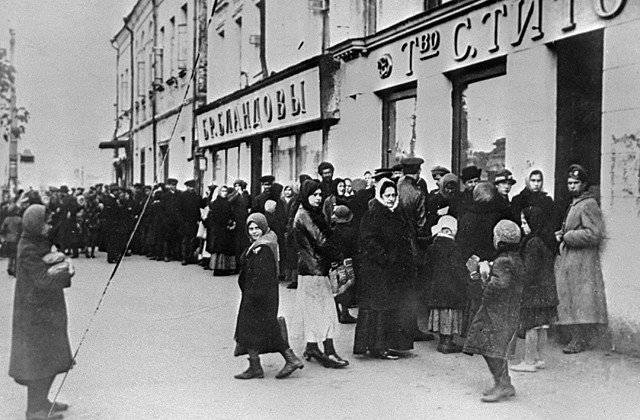
During the Civil War, the city on the Neva suffered losses comparable to the blockade to the Great Patriotic
The Leningrad blockade of 1941 — 1944 led to the fact that out of the three million population in the city, by the end of the war, after a mass evacuation and death rate, no more than 700 thousand people lived. Much less is known that of the nearly two and a half million who lived on the eve of the revolution in Petrograd, about 1921 thousand remained in the city by 700 in the year. Thus, the demographic losses during the years of the Civil War are quite comparable with the blockade.
Bread monopoly
In the second year of the First World War, the Russian Empire faced a food crisis. The country was a peasant, the basis of agriculture, as centuries ago, remained manual labor. Eight million peasants of the most working age were drafted into the army, and already in 1915, the number of arable land in Russia was reduced by a quarter.
The commodity crisis was added to the shortage of bread - two thirds of the industry switched to military production and the shortage of civilian goods instantly generated a surge in prices, speculation and the start of inflation. Problems aggravated crop failure 1916 year. Already in the autumn of that year, the government of the empire tried to set firm prices for bread and began to consider the introduction of a rationing system. At the same time, long before the Bolshevik "pro-detachments", the general staff of the howling army first voiced the idea of the need to forcibly seize bread from the peasants.
But the “firm prices” for bread established by the government were violated everywhere, and the Empire State Council considered the rational system desirable, but impossible to implement, due to the lack of “technical equipment”. As a result, the food crisis escalated. The crisis of the transport system was added to it - the railways barely fed and supplied a huge fighting army, but could no longer cope with other tasks.
At the same time, Petersburg-Petrograd, located in the north-west of Russia, like no other city of the empire, depended on the massive and uninterrupted supply of everything from grain to coal and firewood. Earlier, sea transport played a decisive role in supplying St. Petersburg. But with the outbreak of World War, the Gulf of Finland completely blocked the minefields, and the Baltic Sea closed the fleet of Kaiser Germany. From the autumn of 1914, the entire burden of supplying the capital fell on the railways.
At the beginning of the 20th century, Petersburg was the largest megalopolis of the Russian Empire, whose population doubled over the 20 years. When World War I began, the city was inhabited by 2 100 000 people. It was the industrial and bureaucratic center of the country.
In the first two years of World War, the population of Petrograd increased even more due to the growth of military production in the capital's factories. By the beginning of 1917, the population of the city exceeded the number of 2 400 000 people. It is not surprising that, under such conditions, it was here that for the first time in Russia, the population experienced the food crisis, which resulted in long “tails” of bread lines.
In February, 1917, a riot that began precisely in endless lines at Petrograd bakeries, quickly turned into a revolution. The monarchy fell, but the supply of Petrograd from this has not improved. As early as March 1917, Menshevik Vladimir Grohman, a member of the Provisional Government responsible for food supply, realizing that the former private trade system could not cope with the supply of the city, suggested introducing the grain monopoly, as in Germany.
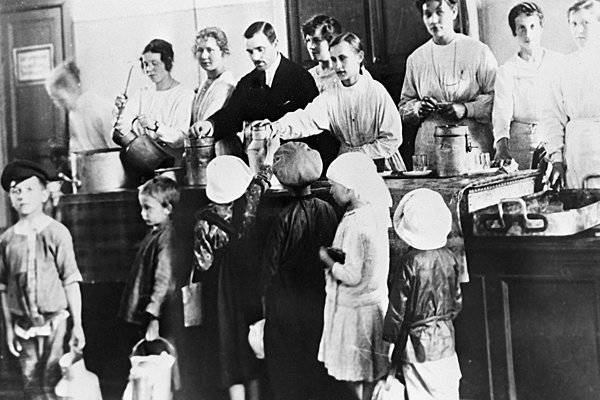
Germany, the first to fight on two fronts, was the first to encounter food shortages and, in 1915, introduced a “grain monopoly”, according to which virtually all peasant products became state property and were distributed centrally by card. Disciplined Germans managed to debug this system and hold out for another three years of war on a starvation diet.
The Provisional Government in the face of the growing food crisis (primarily in Petrograd) decided to repeat the German experience and 25 in March 1917 of the year adopts the law “On the transfer of grain to the state”. Any private trade in bread is prohibited. As we see, everything happened long before the Bolsheviks came to power.
Food committees were created all over the country, which were supposed to buy grain from peasants at fixed prices, fight illegal private trade, and organize the supply of cities. True, in the conditions of inflation and a shortage of goods, the peasants did not hurry to hand over grain at symbolic prices, and the organization of centralized supply faced a lot of technical difficulties.
Country without bread
In May 1917, the Provisional Government even approved the decision to ban baking and selling white bread, rolls and cookies - in order to save scarce butter and sugar. That is, the socialist revolution happened in a country where for six months white bread was banned!
At the cost of great organizational efforts to the Provisional Government and, as contemporaries called it in those days, the “food dictator of Petrograd” V. Groman succeeded in somewhat stabilizing the supply of the metropolis on the Neva. But all and so small successes in organizing the supply of bread for Peter came up against the growing transport collapse of the railways of the former empire.
In April, the 1917 of the year stood idle due to faults 22% of all locomotives in the country. By the autumn of the same year, a third of the locomotives had already risen. According to contemporaries, in September 1917 of the year, railway officials openly took a bribe in 1000 rubles for sending each wagon with grain to Petrograd.
In an effort to establish a state monopoly on bread, the Provisional Government and the authorities of the grain-producing provinces banned private parcels with food. In such conditions, on the verge of starvation in big cities, Russia approached the October Revolution.
Almost immediately after the capture of the Winter Palace, a large echelon arrived in Petrograd with grain collected by Alexander Tsyuryupa, one of the leaders of the Ural Bolsheviks, who had been the head of food council in the rich bread Ufa province since summer 1917. It was this echelon that allowed the new government of Lenin to stabilize the situation with the grain in Petrograd in the first, most critical days after the coup.
Whether this was the intention of the Bolsheviks or a successful coincidence of circumstances is not known now. But from that very moment, Tsuryupa’s large state career began, which already in 1918 would become the People's Commissar of Food of the RSFSR.
The Bolsheviks quickly succeeded in extending their power over most of the territory of Russia, the Moscow revolution quickly turned into a new revolution. The government of Lenin vigorously took up the solution of the most pressing problems. And the first few months of the Soviet regime, the situation with products in Petrograd seemed to stabilize. But by the spring of 1918, politics had sharply intervened again in the economy.
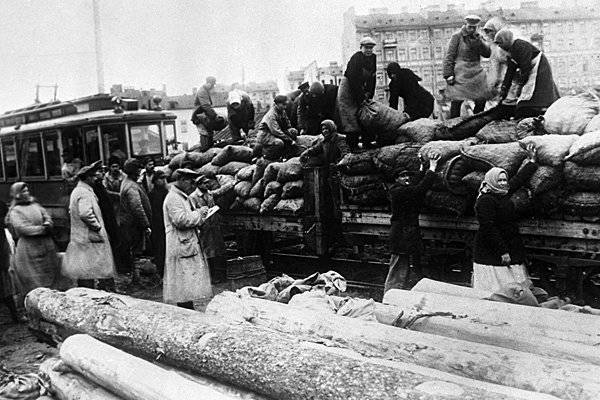
In the spring, Germany and Austria occupied Ukraine, which previously produced half of the grain in the Russian Empire. In May of the same year, the civil war in the Urals and in the Volga region began with the rebellion of the Czechoslovak Corps. The grain-producing regions of Siberia, the southern Urals and central Volga were cut off from central Russia. In addition to Ukraine, the Germans occupied Rostov-on-Don and supported General Krasnov, who defeated the Cossack regions of the Don from the Bolsheviks in May 1918 of the year. So the bread regions of the North Caucasus fell away from Soviet Russia.
As a result, by the summer of 1918, the Bolsheviks remained under the control of the territory, which gave only 10% of the total marketable grain collected in the territory of the former Russian Empire. This meager amount of grain had to be fed to non-black-earth central Russia and the country's two largest megalopolises, Moscow and Petrograd.
If in March 1918, 800 cars with grain and flour arrived in the city on the Neva River, in April it was already half as much. From May 1918, the standardized ration of bread is introduced in Petrograd. At the same time for the first time Petrograd people began to massively eat horses.
In May, 1918, the authorities tried to organize the evacuation of St. Petersburg children to more hearty areas of the country. Several thousand boys and girls aged from 3 to 16 years were sent to the Urals, where so-called “children's nutritional colonies” were organized in the vicinity of Chelyabinsk and Yekaterinburg. But a month later, these areas became the battlefield of the Civil War.
Beginning of hunger
In the summer of 1918, of all the cities of the former empire, it was Petrograd that experienced the most severe problems with food. Chairman of the Petrograd Council, Grigory Zinoviev, in an effort to resolve the issue of grain supply to the city, in June 1918, even began negotiations on possible supplies of bread with the Siberian Socialist-Revolutionary government in Omsk. The Siberian government (Kolchak's predecessor), relying on the bayonets of the Czechoslovak Legion, then fought a full-scale war against the Bolsheviks in the Urals. But in the conditions of the beginning of the famine, the head of Petrograd was ready to pay for bread, even to an open enemy.
Negotiations with whites about buying red bread for Peter did not succeed. In July 1918, the Petrograd Food Commissariat introduced an already differentiated class ration for various groups of the population. So the 1 category (with the largest size of the pro-norm) were classified as hard physical workers, the 2 category was the rest of the workers and employees, and the 3 category were people of free professions (journalists, artists, artists, etc.) to 4, “non-labor elements” (bourgeoisie, priests, owners of large real estate, etc.)
The civil war not only cut off bread from Petrograd, but also diverted the already inadequate rail transport to military transportation. For the whole of August, 1918 reached all the 40 wagons with grain in St. Petersburg — at the same time, it took 100 wagons a day to give every citizen at least 17 grams of bread per day. Under such conditions, the largest plant in the city of Putilov was closed for two weeks - by decision of the Petrograd Soviet, all workers went on two-week leave so that they could feed themselves on the surrounding villages.
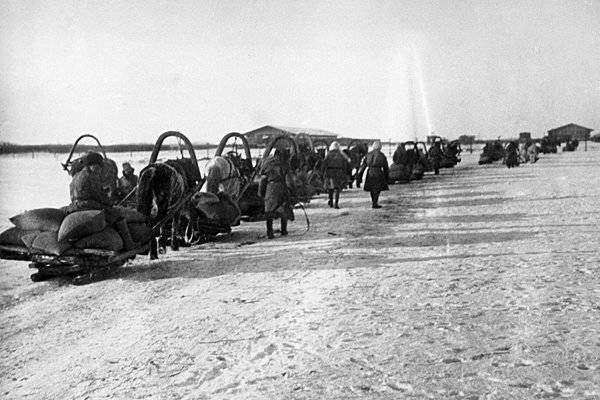
7 August 1918, in the “Proceedings of the Petrograd Commissariat for Food”, published a decree signed by Grigori Zinoviev on allowing individuals to transport up to one and a half pounds of food, including flour or bread, “up to 20 pounds” to Petrograd. In fact, in the face of famine, Petrograd abolished the grain monopoly that existed in the country since March 1917.
After the crisis in August, in the autumn, the price of the titanic efforts to organize centralized deliveries of bread and allow private trade, somewhat improved the food supply of Petrograd. But by the end of the year, because of the new round of civil war, when Kolchak captured the whole of the Urals and went on the general offensive, Peter’s food supply again fell into a deep crisis.
In the winter from 1918 to 1919 the year when food supplies to Petrograd were minimal, the distribution of products using 4 cards, and sometimes 3 categories, periodically stopped. Usually it is served as a special evil of the Bolsheviks before the intelligentsia and the bourgeoisie, forgetting that these segments of the population - especially the former owners of real estate - have kept savings and property since pre-revolutionary times, which they could exchange for bread from black market speculators. The majority of the proletarian population did not have such opportunities.
As of January 1919, Peter’s population was about 1 300 000 people, that is, in just a year and a half, it has shrunk by more than a million. Most left the hungry and cold city. Mass mortality has begun. By the beginning of 1919, in Petrograd, there was only a third of factory workers from their number a year earlier.
In addition, the 1919 year was the time of two great white attacks on Petrograd from the west, from Estonia. In June and October, General Yudenich’s troops twice approached the distant outskirts of the city. The Baltic Sea had been blocking the British fleet all this time, and supplies from Finland were also impossible - local White, actively hostile towards Soviet Russia, ruled after their civil war.
In fact, Petrograd found itself in a real blockade. All the supply of the city in those conditions kept, in fact, on the same railway line from Tver. But during the fighting, which went on the outskirts of the city for the whole 1919 year, the army was supplied with food first of all - for example, in June of that year, there were thousands of 192 people and 25 thousands of horses in the Petrograd military district. The rest of the urban population barely operating transport supplied in the last turn.
Petrograd ration
The increasing collapse of the railways led to the fact that even available food was hardly delivered to the city. For example, in 1919, one of the echelons with salted fish from Astrakhan moved to Petrograd for more than two and a half months and the product arrived at its destination damaged.
According to statistics, in Petrograd, the daily ration of bread for an average of 1919 a year was for a working 120 grams and 40 grams for a dependent. That is, it was purely symbolic. At increased rates only some military manufactures were supplied, such as the Putilov factory.
In July, 1919, the Food Commissariat allowed the workers returning from the holidays to bring with them up to two pounds of food unhindered. As a result, over the next month, over 60 thousands of proletarians of St. Petersburg — almost half of the total number of workers — left the enterprises and went on vacation to the countryside for food.
A worker at the Petrograd plant “Siemens” Platonov, speaking on December 17 1919, at a meeting of the executive committee of the Petrograd Soviet, testified: “In our canteens, we cooked soup for a few days from the cleanings, and made rotten potatoes out of cutlets”. The supply of civil servants was not the best, and the supply of the rest of the population at the height of the Civil War was often simply absent.
By the beginning of 1920, the population of Petrograd was reduced by another half a million people - to 800 thousands. At the same time, it cannot be said that the city government headed by Zinoviev was inactive - on the contrary, she worked and was very active. In addition to the distribution of bread on the cards, the authorities were engaged in creating a system of canteens, organized free food for children, centralized baking of bread, etc. From the St. Petersburg workers formed food detachments, which were sent for food to the grain-growing gubernia.
But all this did not solve the question of supply. First, there was little bread. Secondly, the transport and financial system, shaken by the revolutions of the world and civil wars, did not allow to organize uninterrupted supply even with the insufficient amount of bread that was.
Fuel hunger
But any large city, even a century ago, depends not only on the supply of food, but also on uninterrupted and sufficient supply of fuel. Petrograd is not a southern city at all, and for normal life it demanded impressive amounts of fuel — coal, oil, firewood.
In 1914, the capital of the Russian Empire consumed almost 110 million pounds of coal and almost 13 million pounds of oil. If during the Civil War, the railways could not cope with the supply of bread, then all the more they could not cope with the transportation of fuel. In addition, qualitative coal in the country was then produced mainly by the Donbass, and oil - by Baku. In 1918 — 1920, these sources of energy were repeatedly cut off by fronts. Therefore, it is not surprising that at the height of the civil war, coal came to Petrograd in 30 times less than in 1914.
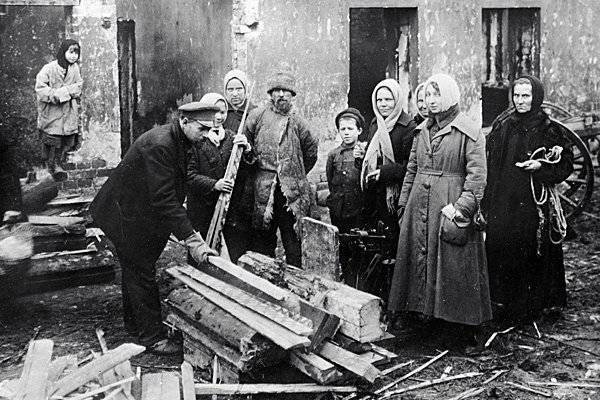
The first major fuel crisis in the city broke out in January 1919 of the year - there was no coal, no firewood, no oil. That month, due to the lack of fuel, dozens of enterprises were closed. The Petrograd Soviet, seeking to find a solution to the fuel crisis on its own, decided to turn off electrical lighting in order to save energy, minimize the work of enterprises and organize the procurement of firewood, peat and shale in the surrounding areas around Petrograd.
When, in April 1919, the chairman of the Petrograd Soviet, Grigory Zinoviev, turned to the Council of People's Commissars with a request to send at least a little black oil and oil to the city, he was answered with a very laconic telegram: "There is no oil and there will not be."
The situation with the supply, more precisely with the lack of fuel supplies to Petrograd, was such that the idea of a general evacuation of the St. Petersburg industry closer to the sources of bread and fuel sounded more than once. 15 September 1919 was the chairman of the main economic body of Soviet Russia, the High Council of the National Economy, Aleksey Rykov, who proposed to evacuate the most important Petrograd enterprises to the Urals due to the lack of fuel, and send workers of Petrograd to different regions of the country to restore industry. But even the Bolsheviks did not dare to take such a radical decision.
Already the first year of the civil war significantly reduced the industry of Petrograd. Thus, the number of workers in the city’s largest Putilov plant fell twice, from 23 to 11 thousand. The number of workers at the Petrograd Steel Plant was three times less, the Machine-Building Plant was four times less, and the Mechanical Plant was ten times less.
Without relying on the help of the center, the Petrograd authorities tried to solve the fuel crisis on their own. Back in December, 1918 of the year in Petrograd and the surrounding areas, the conscription of all workers in the fuel industry, including lumberjacks, logging trucks, peatlands and coal miners, was suspended. Under the conditions of the Civil War, fuel was primarily required for the continuation of the work of the military factories of Petrograd, therefore in October 1919 was transferred to the Petersburg factories all the stocks of firewood within 100 radius versts the city. At the same time, there was a mobilization of Petrograd workers for the procurement of firewood and peat in the neighboring provinces.
The fuel crisis was considered no less dangerous than the military. Therefore, immediately after the defeat of the white troops of Yudenich, 20 in January 1920, Grigory Zinoviev proposed to organize from the units of the 7 Red Army defending the city a special Labor Army with special tasks to extract peat and develop oil shale in the vicinity of Petrograd.
But the fuel was still not enough, and the city began to eat itself. For 1920 a year, Petrograd utilities workers dismantled more than 1000 houses for firewood. Not a smaller number of wooden buildings in the city were saved from the cold by the residents themselves burned in the stoves, "stoves". The artisan tin furnace, which was installed and fired as it went straight into the living room, became a symbol of the Civil War in Petrograd.
Epidemics and the end of the first blockade
Devastation and fuel shortage hit even the city water supply. In the 1920 year, he fed water and a half times less than on the eve of the revolution. At the same time, due to a malfunction of a pipe that had not been repaired for a long time, up to half of the water went into the ground. In the summer of 1918, the temporary cessation of the chlorination of tap water caused an outbreak of cholera epidemic in Petrograd.
Numerous epidemics and contagious diseases accompanied the city throughout the years of the Civil War, aggravating the losses from hunger and cold. Urban horses eaten from hunger meant not only the absence of cab drivers, but also the cessation of the removal of sewage and garbage. To this was added the lack of medicines, the shortage of soap and fuel for the baths. If in the 1914 year there were over two thousand doctors in the city, then by the end of 1920 there were less than a thousand of them.
Therefore, the years of the Civil War in Petrograd turned into an almost continuous series of epidemics. In the spring of 1918, the city was struck by the first epidemic of typhus. From July, it was replaced by an epidemic of cholera that raged in the city through September 1918. And after her in the fall began the epidemic of influenza Spaniard. In the autumn of 1919, the second epidemic of typhus began and continued throughout the winter, until the spring of 1920. However, by the end of the summer of 1920, Petrograd experienced a real epidemic of dysentery.
In 1920, the population of the city reached a minimum during the Civil War - about 720 thousand people. In the same year, the total gross output of the Petrograd industry was only 13% of the year’s 1914 level.
In February 1921, at the special meeting of the All-Russian Central Executive Committee, the “Petrograd Question” was discussed separately. It was officially recognized that, as a result of the Civil War, Petrograd was ravaged more than any other city in Russia, suffered the most victims and can no longer be restored on its own without the help of the whole country.
The end of the Civil War immediately allowed to solve a number of urban problems. At the beginning of 1922, food for Petrograd was purchased abroad, and firewood in Finland due to the devastation on the railways was all easier and faster to deliver by sea directly to the city port. Bread and firewood were purchased using valuables confiscated from the church.
Over the summer of 1922, about a million pounds of grain and almost two hundred thousand pounds of sugar arrived in the port of Petrograd from abroad. During the period of navigation, from May to October of that year, around the 1914 of foreign steamers arrived at the city port, closed from 500, due to military operations.
1922 year brought a rich harvest, the first fruits of the NEP and the first results of the restoration of the country's economy and transport. By the end of 1922, the crisis was finally over - the Civil War, and with it the first blockade of the city on the Neva ended.
Information